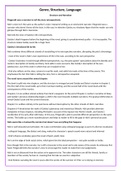Genre, Structure, Language:
Structure and Narration
Fitzgerald uses a narrator to tell the story retrospectively:
Nick’s voice isn’t the same as the author’s voice: instead of writing as an omniscient narrator, Fitzgerald uses a
narrator who doesn’t know all the facts. In this way, he sketches Gatsby as a shadowy figure that the reader can only
glimpse through Nick’s memories.
Nick tells the story of Gatsby’s life retrospectively.
Gatsby’s death happens before the beginning of the novel, giving it a predetermined quality – it is inescapable. The
structure makes Gatsby seem like a tragic hero.
Gatsby is introduced bit by bit:
Nick combines three different strands of storytelling in his retrospective narrative, disrupting the plot’s chronology:
- most of the novel is Nick’s own experiences of life in the east, according to his own perspective
- Gatsby’s backstory is told through different perspectives, e.g. the party guests’ speculations about his identity and
Jordan’s description of Gatsby and Daisy. Nick adds in some accounts, like Gatsby’s description of his own
adolescence, out of the order in which they are revealed to him.
- Nick also reflects on the story, returns to read his work, and adds lists made at the time of the events. This
emphasises the fact that Nick is telling the story from a retrospective viewpoint.
The novel turns around the central chapter:
The book is split into nine chapters, and the structure is arranged around Gatsby and Daisy’s reunion in chapter 5.
The first half of the novel builds up to their eventual meeting, and the second half of the novel deals with the
consequences of the reunion.
Chapters 1-4 are written almost entirely from Nick’s viewpoint. At the end of Chapter 4, Jordan’s narrative of Daisy
and Gatsby’s previous relationship begins a shift in the novel towards multiple narratives. The gradual shifts helps to
reveal Gatsby’s past and his current character.
Chapter 5 is written entirely in the past tense without interruption by the other strands of Nick’s narrative.
Chapters 6-9 break down the myth of Gatsby’s glamorous and mysterious lifestyle. Nick provides alternate
viewpoints in these chapters, including Michaelis’s account of the inquest into Myrtle’s death, and Gatsby’s
recollection of his early affair with Daisy. In this way, Fitzgerald is able to provide different perspective on the same
events. The builds up a more rounded picture and helps to reader to fill in the gaps in Nick’s personal account.
Nick seems like a trustworthy narrator but doesn’t see everything that happens:
Nick is well-educated and articulate. He is also comfortable using colloquial language as part of a diverse vocabulary:
- colloquial language, like dialect and slang, makes the character’s speech sound more natural and informal
- Nick’s diverse vocabulary gives the novel a fluent, poetic tone.
He is on the edge of both social circles, which gives him the ideal perspective – not quite outside or inside.
Even though Nick is the narrator, he is still a character in the novel and is only aware of the events he witnesses first
hand. Fitzgerald limits the narrator’s view to encourage the reader to make their own judgements.
Nick is not as distanced from the action as he appears to be. The other characters are still his friends, family or
members of the society he lives in, meaning that his take on events is subjective:
- Nick finishes narrating the novel 2 years after the events of the summer of 1922, so is relying on memory





